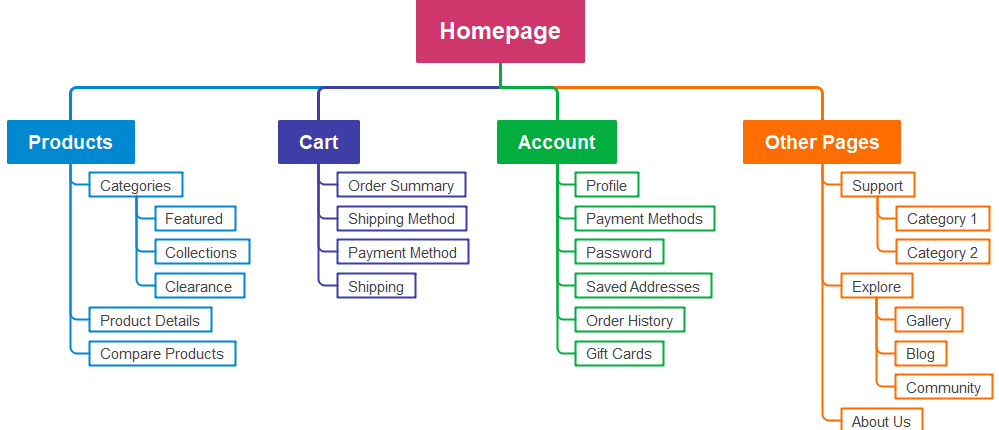Today I read a quite good article about eCommerce Sitemaps on http://blog.referralcandy.com/.
According to the Google help files for sitemaps, you could list up to 50,000 files in an individual sitemap, which would cover almost every website, except very large portals.
The eCommerce sitemap is important for several reasons:
1. Improved User Experience: A well-organized sitemap helps users navigate your eCommerce website more easily, allowing them to find products, categories, and content quickly and efficiently. This can enhance the overall user experience and reduce bounce rates by ensuring that visitors can easily locate what they’re looking for.
2. Better Indexing by Search Engines: Search engines use sitemaps to crawl and index the pages of your website more effectively. By providing a comprehensive sitemap, you help search engine bots discover and understand the structure of your eCommerce site, which can improve your site’s visibility in search engine results pages (SERPs) and drive organic traffic.
3. Facilitates Category and Product Discovery: An eCommerce sitemap typically includes links to product categories, subcategories, and individual product pages. This makes it easier for users to discover and explore different products and offerings available on your website, increasing the likelihood of conversion and sales.
4. Supports SEO Efforts: A well-structured sitemap can help improve your website’s search engine optimization (SEO) by ensuring that all important pages are properly indexed and accessible to search engines. This can lead to higher rankings for relevant keywords and improved visibility in search results, driving more organic traffic to your eCommerce site.
5. Promotes Internal Linking: A sitemap facilitates internal linking by providing a centralized list of all pages on your website. Internal linking is important for SEO as it helps distribute link equity throughout your site, improves crawlability, and establishes relationships between different pages and content.
6. Assists with Site Architecture Planning: Creating a sitemap requires you to think critically about your website’s structure and organization. It can help you identify any gaps or inconsistencies in your site architecture and make necessary adjustments to improve usability and navigation.
7. Supports Mobile and Voice Search: With the increasing use of mobile devices and voice search, having a well-optimized sitemap is crucial for ensuring that your eCommerce website is accessible and user-friendly across different devices and search interfaces. A sitemap can help search engines understand the mobile version of your site and improve its visibility in mobile search results.
Overall, an eCommerce sitemap is an essential tool for improving user experience, enhancing search engine visibility, and driving traffic and sales to your online store. It serves as a roadmap for both users and search engines, helping them navigate and understand the structure and content of your eCommerce website more effectively.
However it is a much more effective and easier to maintain configuration to use multiple sitemaps – but use the sitemap index map first ( WordPress SEO plugin will help you with it)
- Products Only – this XML file will list only individual products and will be modified as new products are added/removed.
- Categories Only – this XML file will have only the category or department pages.
- Images – this XML file will have the images only
- Video – this XML file will have the videos only
- Mobile – mobile website sitemap XML
- News – news XML
If you have multiple stores on one platform like Magento, you should add e-commerce sitemaps per store.
Yoast SEO
is a great free plugin for WordPress that will create in easy steps all needed sitemaps for you.
- Get more visitors from Google and Bing
- Attract more visitors from social media
- Increase your readers’ engagement
XML Sitemap Generator
is a tool for all types of sitemaps, especially for huge online shops. You need to buy and install it on your hosting server.
E-commerce sitemap can be very easily generated:
- It has no limits on the number of pages included in sitemap
- It generates any kind of sitemap you require:
XML sitemap
HTML sitemap
Text formatted sitemap
Mobile sitemap
Images sitemap
Video sitemap
News sitemap
RSS Feeds - Images information can be optionally included in an e-commerce sitemap
- It will work on all sites including dynamic websites such as portals, blogs, forums, and online stores.
- Fast and easy installation onto the same host that should be crawled
- Support of LARGE websites, dividing the sitemap into the parts per 50,000 URLs each and creates a Sitemap Index file according to the Google sitemap protocol.
- Informs (ping) Google and other search engines automatically when sitemap generation is complete
- Any broken links that are detected by the application are reported on a special page, providing you with the URLs pages that refer to these bad links enabling you to fix them and keep the search engine robots on your site.
- Can be setup automatically with a cron job to create sitemaps without any user interaction
- Free Updates for life.
Personally I use Yoast for SEO purposes. It also has many nice features and the automated e-commerce sitemap or web sitemap generation.
Without an XML sitemap
— or even without a manually updated sitemap page — you might run into the following problems:
- New pages can take a long time to be discovered, especially if they aren’t linked heavily from other product pages.
- Your product images might not be included in image search results, because they’re largely dependent on sitemaps to be indexed.
- Updates you make to pages might not help your rankings for a long time, because you aren’t providing search engines with metadata (including when the page has been updated).
- The fewer links your store has, the more likely it is to be excluded from searches, because Google doesn’t yet know about all of your pages, your store’s relevancy, and whether or not it can fully trust you. Essentially, all these SEO little factors add up.
The long and short of it is this: without a sitemap, search engines can and will still crawl and index your store for inclusion in search results. But a sitemap makes the process much, much faster.
Submitting your sitemap to search engines: two ways
Before you call it a day, you’ll need to do an initial submission of your sitemap to the major search engines. There are two relatively easy ways you can do this:
- Adding a line to your site’s robots.txt file, or
- Submitting the XML file via Google and Bing’s Webmaster Tools.
To submit via robots.txt, simply locate (or create) this file in your site’s top-level directory and add this line at the bottom:
Sitemap: http://www.example.com/sitemap.xml
This will tell any search engine crawlers where your sitemap is located so they can index it.
If you’d rather submit the file via Webmaster Tools, you will need to sign up for Google and Bing’s WMT accounts first. Once you are signed up and your store has been verified, follow their instructions to submit your sitemap.
Note that submitting via this method will only cover the Google, Bing, and Yahoo! search engines (Bing’s Webmaster Tools also covers Yahoo!). So if you are concerned about smaller search engines and comfortable editing your robots.txt file, consider that instead or even along with the WMT method.
Updating your sitemap
Once your sitemap exists, you might ask “what do I do when I’ve changed something on my store? I’ll need to update the sitemap, right?”
Here’s the good news: if you’re using a plugin to generate an XML sitemap for you, the XML file will be automatically updated with any changes you make. This includes any changes to URLs or metadata (specifically, the “last updated” date).
It is the best solution. All online shop CMS also uses this feature. Simply you should assign a job in cron-job on the server and you are done.
The sitemap is a small detail with a big impact
While most components of your online store are meant for humans, the sitemap is one that’s meant for, well, robots. But it can have a big impact on how your store is found in searches, which is why it’s so important to make sure you have one!
Now it is also a new aspect – mobile friendliness and structural data on your pages. Both are checked by robots and both of them have an impact on your search results.
Have any questions about your store’s sitemap or how you can create it?
Feel free to comment below — we’re always happy to help out.



Share this entry